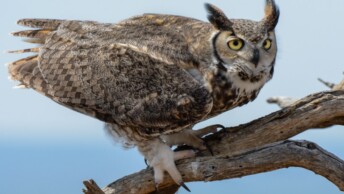The elf owl is the world’s smallest owl, measuring just 12 centimeters (4.7 inches) in length and weighing as little as 35 grams (1.2 ounces). Close behind are the long-whiskered owlet and Tamaulipas pygmy owl – two elusive forest species with males barely 13 centimeters (5.1 inches) long and around 50 grams (1.8 ounces) in weight.
This article explores the smallest owls known to science, focusing on the lightest and shortest individuals recorded in the wild. These miniature raptors inhabit an extraordinary range of environments, from cactus-studded deserts to misty cloud forests and cool montane woodlands. Here we look at how their size shapes their hunting and behavior, how they survive despite their vulnerability, and why these tiny owls warrant particular attention in conservation.
Elf Owl
Micrathene whitneyi
- Body length: As small as 12 cm (4.7 in).
- Weight: As little as 35 g (1.2 oz).
- Wingspan: Around 25 cm (9.8 in).
- Where found: Southwestern United States and Mexico, in deserts, thorn scrub, pine-oak woodlands, and riparian forests.
- Conservation status: Least Concern; populations stable to slightly declining but still widespread across suitable habitats.
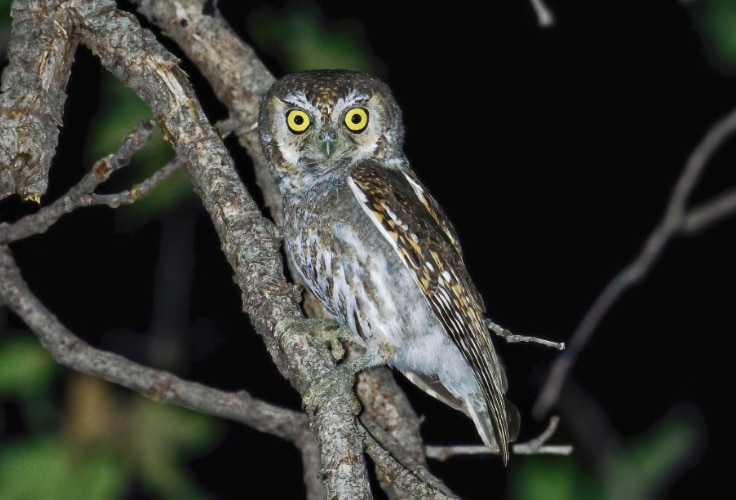
The elf owl is the smallest and lightest owl in the world, and also the tiniest bird of prey across all raptor groups. The smallest individuals measure just 12 centimeters (4.7 inches) in length and weigh as little as 35 grams (1.2 ounces). With a wingspan of only about 25 centimeters (9.8 inches), this sparrow-sized owl moves with surprising agility, darting through thorny desert vegetation and weaving among cacti in the arid borderlands of the southwestern United States and Mexico. By day it disappears into abandoned woodpecker holes or tree cavities, its mottled plumage blending seamlessly with bark and cactus skin.
Its miniature scale defines every aspect of its lifestyle. The elf owl feeds mainly on insects and other arthropods, hunting with quick, direct flights from low perches. It plucks moths from blossoms, snaps beetles from foliage, or hovers to seize prey mid-air. Sometimes it drops to the ground or even runs and climbs in pursuit of food. Small vertebrates like lizards or threadsnakes are taken occasionally, and in a unique behavior, live threadsnakes are carried to nests where they consume parasites that threaten the chicks. Despite its size, the elf owl fiercely defends its nesting cavity, joining mates or neighbors in noisy mobbing displays against snakes, larger owls, and mammals.
This species breeds in scattered populations across the deserts and woodlands of the southwestern United States, from southern California and Arizona to western Texas, and south through much of Mexico. It winters farther south in western and central Mexico, following seasonal insect abundance. Typical nest sites are cavities made by large woodpeckers in trees or giant cacti, which offer shade and safety. Although local declines have occurred from habitat loss and disturbance, the elf owl remains widespread and adaptable, benefiting from cavity-nest box programs and reforestation of riparian zones.
Long-Whiskered Owlet
Xenoglaux loweryi
- Body length: As small as 13 cm (5.1 in).
- Weight: As little as 46 g (1.6 oz).
- Where found: Endemic to humid montane forests of northern Peru, mainly around Abra Patricia and Cordillera de Colan.
- Conservation status: Vulnerable; population extremely small and localized, affected by ongoing habitat loss and disturbance.
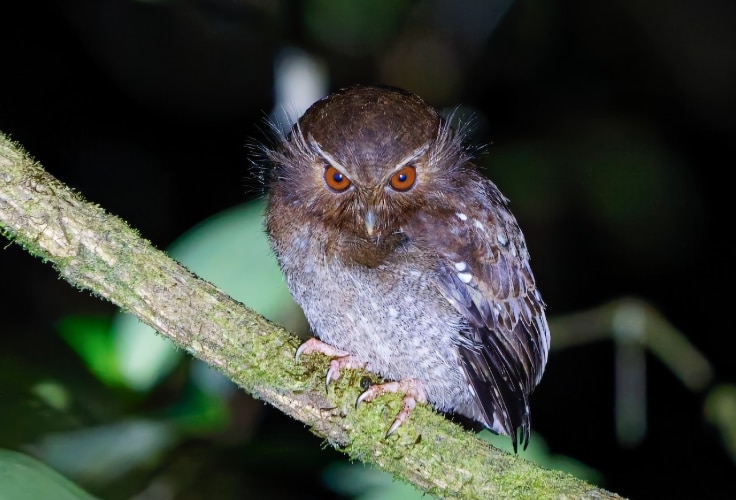
The long-whiskered owlet is one of the world’s smallest and most enigmatic owls, measuring only 13 centimeters (5.1 inches) in length and weighing around 46 grams (1.6 ounces). Its long, delicate facial “whiskers,” short wings, and tiny tail give it a peculiar appearance unlike any other owl. Found only in the mist-shrouded cloud forests of northern Peru, this miniature species moves quietly through dense vegetation and may even be partly adapted for short, hopping or gliding movements rather than sustained flight. Its fine brown plumage and heavy feathering help it disappear into moss-covered branches, making sightings exceptionally rare.
Little is known about its behavior, but it is nocturnal and probably insectivorous. Most observations occur at night when individuals respond to playback with a soft, descending hoot or a burry whistle repeated every few seconds. It appears to forage within the lower forest strata and dense understory, possibly ambushing or gleaning insects from foliage. Its small size and short, rounded wings likely favor maneuverability within the tangled vegetation of elfin forest, where open flight would be nearly impossible.
This species occurs only within a narrow range in the eastern Andes of northern Peru, chiefly around Abra Patricia and the nearby Cordillera de Colan. It inhabits stunted, moss-laden cloud forests, environments rich in orchids, bromeliads, and bamboo. The owlet’s survival depends on these humid high-elevation forests, many of which are being cleared for agriculture, logging, and mining. Although large tracts of intact forest remain in remote or protected areas, the total population is likely fewer than 1,000 mature individuals, making continued protection of these cloud-forest corridors vital for one of the rarest and least known owls on the planet.
Tamaulipas Pygmy-Owl
Glaucidium sanchezi
- Body length: As small as 13 cm (5.1 in).
- Weight: As little as 51 g (1.8 oz).
- Where found: Endemic to northeastern Mexico, mainly in southern Tamaulipas and eastern San Luis Potosi, in subtropical and montane forests.
- Conservation status: Near Threatened; range-restricted and declining locally from logging and habitat loss.
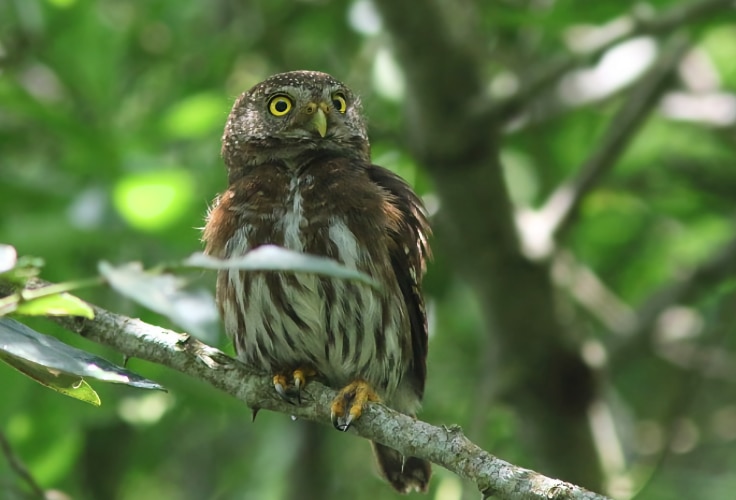
The Tamaulipas pygmy-owl is one of the smallest owls in North America, measuring only about 13 centimeters (5.1 inches) long and weighing around 51 grams (1.8 ounces). Endemic to the cloud forests and humid highlands of northeastern Mexico, it is a secretive canopy-dweller, more often heard than seen. Like other pygmy-owls, it has a compact, round-headed form and short, rounded wings suited to maneuvering through dense foliage. Its soft brown plumage and fine spotting blend perfectly with the shaded understory, offering near-total concealment in the dim forest light.
Although seldom observed, the Tamaulipas pygmy-owl is known to hunt both by day and night, feeding mainly on insects, small reptiles, and other tiny vertebrates. It typically perches quietly within the midstory or forest edge, darting out in short, direct flights to capture prey. Its voice – a series of slow, hollow hoots repeated at intervals, is often the only sign of its presence. As with other Glaucidium owls, it nests in abandoned woodpecker holes or natural cavities, relying on mature forest trees for both roosting and breeding.
This miniature owl has one of the most restricted ranges of any North American raptor, limited to a small portion of the Sierra Madre Oriental in Tamaulipas, San Luis Potosi, and northern Hidalgo. It inhabits subtropical evergreen, semi-deciduous, and pine-evergreen montane forests. The species remains uncommon but can still be found near towns such as Gomez Farias and El Naranjo. Logging and forest conversion continue to erode its limited habitat, and recent surveys suggest that its actual range is smaller and more fragmented than once believed, highlighting the need for careful monitoring and forest protection in this unique corner of northeastern Mexico.
Ferruginous Pygmy-Owl
Glaucidium brasilianum
- Body length: As small as 14 cm (5.5 in).
- Weight: As little as 53 g (1.9 oz).
- Wingspan: As short as 30 cm (11.8 in).
- Where found: From the southwestern United States through Central and South America, in habitats ranging from dry desert scrub to humid tropical forest.
- Conservation status: Least Concern; widespread and locally common, though some northern populations face local threats.
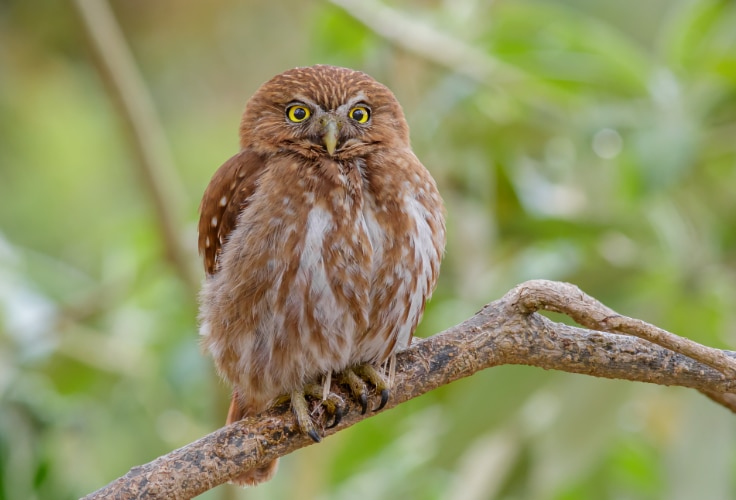
The ferruginous pygmy-owl is among the most widespread and familiar little owls of the Americas, found from Arizona and Texas all the way to Argentina and Chile. The smallest males measure just 14 centimeters (5.5 inches) and weigh barely 53 grams (1.9 ounces), yet they are capable of taking prey several times their size. With its round, tuftless head, and long barred tail, this tiny owl looks almost like a plump songbird at first glance, but its fierce yellow stare and disproportionately large feet and talons quickly give it away.
Active both by day and at dusk, this species hunts boldly from low perches, striking small birds, reptiles, rodents, and insects with sudden dives. Its flight, unlike that of most owls, is audible and somewhat undulating, resembling a woodpecker’s. Because its ears are symmetrical, the ferruginous pygmy-owl relies primarily on keen eyesight rather than hearing – a fitting adaptation for a diurnal hunter. Its steady tooting call often attracts noisy mobs of small birds, which instinctively harass it as a dangerous predator.
Highly adaptable, the ferruginous pygmy-owl occupies a remarkable range of environments, from thorn scrub and mesquite woodlands in the Sonoran Desert to tropical forests, coffee plantations, and even city parks. It nests in tree cavities, especially abandoned woodpecker holes, and is resident throughout most of its range. While northern populations have suffered local declines from habitat loss, this small, fearless owl remains abundant across the Neotropics and a familiar figure wherever wooded habitats meet open ground.
Flammulated Owl
Psiloscops flammeolus
- Body length: As small as 15 cm (5.9 in).
- Weight: As little as 43 g (1.5 oz).
- Wingspan: Around 36 cm (14.2 in).
- Where found: Montane pine forests of western North America, breeding from southern Canada and the western U.S. to central Mexico.
- Conservation status: Least Concern; populations stable but dependent on mature forest and insect abundance.

The flammulated owl is the most common small owl of the montane pine forests of western North America. The smallest males measure only about 15 centimeters (5.9 inches) in length and weigh around 43 grams (1.5 ounces), yet this tiny, migratory species covers vast distances between its northern breeding grounds and wintering areas in Mexico and Central America. It belongs to a genus of its own, Psiloscops, and can be recognized at once by its large, dark eyes and finely vermiculated plumage washed with rusty tones that blend seamlessly with pine bark.
Strictly nocturnal, the flammulated owl hunts by night from high perches within large conifers, taking mostly insects such as moths, crickets, and beetles. It forages with short, quick flights and occasional hovering, sometimes plucking prey directly from foliage. Its low, muffled hoot carries softly through the forest, making it easier to hear than to see. Unlike many other owls, it relies almost entirely on arthropods rather than small vertebrates, and its migratory behavior likely evolved to track seasonal insect availability.
This species breeds in mature pine, fir, or mixed conifer-aspen forests from southern British Columbia and the Rockies to the highlands of Mexico, nesting in old woodpecker holes or natural cavities. It prefers open, semi-arid forest with a rich insect fauna and retains a strong association with old-growth stands that provide suitable nesting cavities. Although sensitive to logging and pesticide use that reduce its food supply, the flammulated owl remains locally common and widespread – a distinctive, dark-eyed symbol of North America’s mountain forests.
Eurasian Pygmy-Owl
Glaucidium passerinum
- Body length: As small as 15 cm (5.9 in).
- Weight: As little as 47 g (1.7 oz).
- Wingspan: Around 34 cm (13.4 in).
- Where found: Across boreal and montane forests of northern and central Eurasia, from Scandinavia to Siberia.
- Conservation status: Least Concern; widely distributed with stable overall populations.
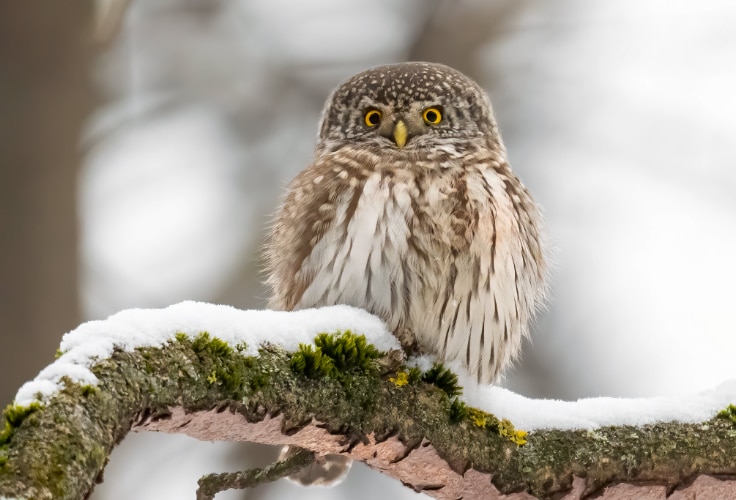
The Eurasian pygmy-owl is the smallest owl in Europe. Measuring just 15 centimeters (5.9 inches) in length and weighing around 47 grams (1.7 ounces), it appears scarcely larger than a sparrow. Despite its tiny size, it is a capable and bold hunter. Its compact body, short tail, and rounded wings let it dart swiftly among conifers and forest openings, while the bright yellow eyes and rounded face give it an unexpectedly cute, endearing look. By day it often perches quietly near the tops of spruces, but around dusk it becomes highly active, giving a series of clear whistled toots that carry far through the woods.
Tiny though it is, this owl lives the life of a full-sized raptor. It hunts mainly small mammals, especially voles, and small birds up to the size of finches or thrushes. Hunting usually takes place from a perch, with the owl gliding down to strike prey with its feet and delivering a quick bite to the head or snout. In years of vole scarcity it shifts toward more bird prey, particularly fledglings. It often stores food for later use, caching dozens or even hundreds of items in tree holes or cavities. These stored reserves are vital through the long northern winters, when daylight is short and hunting conditions harsh.
The species occupies coniferous and mixed forests across a vast range from Scandinavia and the Alps east through Russia to Siberia and northeastern China. It favors mature spruce and fir stands with openings, meadows, or clearings for hunting and woodpecker-made cavities for nesting. Most populations are resident, though northern birds may move southward or to lower elevations in severe winters. Although local declines have been linked to forest loss and competition from larger owl species, the Eurasian pygmy-owl remains widespread and relatively secure – a hardy miniature hunter thriving in the cool forests of Eurasia.
Northern Pygmy-Owl
Glaucidium gnoma
- Body length: As small as 15 cm (5.9 in).
- Weight: As little as 55 g (1.9 oz).
- Wingspan: Around 30 cm (11.8 in).
- Where found: Widespread in western North America, from Alaska and Canada south through the U.S. mountains to Central America.
- Conservation status: Least Concern; populations stable but locally affected by loss of standing dead trees used for nesting.

The northern pygmy-owl is the most widespread and regularly encountered small owl in the United States and Canada, found across much of the western mountains and forests. The smallest males measure just 15 centimeters (5.9 inches) in length and weigh about 55 grams (1.9 ounces), yet they regularly prey on birds several times their size. With its rounded head, long tail, and bright yellow eyes, this tiny owl resembles a sparrow more than a raptor – until it strikes.
Unusually for an owl, it is fully diurnal, perching openly during the day to scan for movement. Its hunting style is deliberate and stealthy: short flights between perches followed by sudden, direct attacks on small birds, mammals, or lizards. Insects are also taken, especially in warmer regions. Despite its diminutive size, it often captures prey up to three times heavier than itself. Songbirds frequently gather to harass or mob it, giving away its presence to attentive birdwatchers.
This species inhabits forests and woodlands across western North America, from Alaska and southern Canada through the Rocky Mountains and coastal ranges to Central America. It favors mature and mixed montane forests rich in cavities for nesting and perches for hunting. Nests are placed in abandoned woodpecker holes or natural cavities, typically in old or decaying trees. Although locally vulnerable to logging practices that remove standing dead wood, the northern pygmy-owl remains widespread and adaptable – a bold little predator that adds life and intrigue to the mountain forests of the West.
African Scops-Owl
Otus senegalensis
- Body length: As small as 16 cm (6.3 in).
- Weight: As little as 45 g (1.6 oz).
- Wingspan: As short as 40 cm (15.7 in).
- Where found: Widely across sub-Saharan Africa in wooded savannas, open woodland, and large gardens with trees.
- Conservation status: Least Concern; common and widespread, though local declines occur where woodlands are cleared.
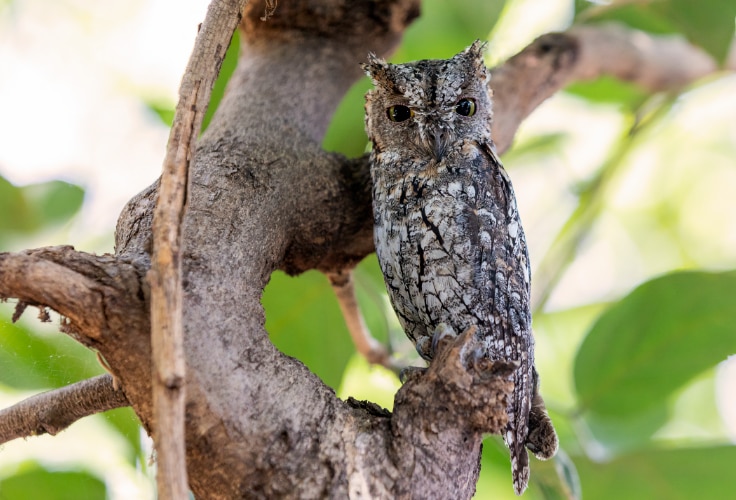
The African scops-owl is Africa’s smallest owl and the most widespread member of the Otus genus on the continent. The tiniest individuals measure just 16 centimeters (6.3 inches) in length and weigh as little as 45 grams (1.6 ounces). Compact and finely built, it has short ear tufts, gray-brown or rufous-brown plumage, and intricate streaking that mimics the texture of bark. When roosting, it aligns its body with a branch or trunk and becomes almost invisible, relying on perfect camouflage to avoid detection during the day.
By night, it becomes active and highly vocal. Its distinctive, frog-like “prreeeuup” call, repeated every few seconds, often betrays its presence long before it is seen. The species hunts mainly large insects and other arthropods, occasionally small vertebrates, by dropping from low perches to seize prey on the ground or in foliage. It also catches flying insects around streetlights and may even forage on foot along fallen logs or riverbanks. Despite its minute size, it shows remarkable versatility, thriving in habitats ranging from arid acacia savanna to moist woodland.
The species occupies a vast swath of sub-Saharan Africa, from Mauritania and Ethiopia south to South Africa and the island of Annobon. It inhabits wooded savannas, dry broadleaf and mopane woodlands, and park-like habitats, and often ventures into gardens and villages with large trees. Nests are placed in natural cavities or old woodpecker holes, usually a few meters above the ground. Although the clearing of woodlands and charcoal production have reduced suitable habitat in some areas, this adaptable species remains widespread and locally common, thriving wherever scattered trees and open ground provide cover and hunting space.
Collared Owlet
Taenioptynx brodiei
- Body length: As small as 15 cm (5.9 in).
- Weight: As little as 52 g (1.8 oz).
- Where found: Across the Himalayan region, central and southeastern China, Taiwan, and montane areas of Southeast Asia.
- Conservation status: Least Concern; widespread and generally common, though sensitive to forest loss.

The collared owlet is the smallest owl in Asia, measuring just 15 centimeters (5.9 inches) in length and with tiny males weighing about 52 grams (1.8 ounces). It is easily recognized by its rounded head, golden eyes, and the curious “false face” pattern on the back of the neck – a pair of dark patches resembling eyes that likely deter predators. Despite its size, this owl is a bold and active hunter, often perched conspicuously during the day and attracting the noisy mobbing of smaller birds.
Unlike most owls, the collared owlet is largely diurnal, hunting throughout daylight hours as well as at dusk and night. It feeds primarily on small birds but also takes insects, rodents, and lizards, sometimes catching prey nearly as large as itself. Hunting from a perch, it swoops quickly to snatch victims in flight or off branches, holding larger catches in one foot while tearing them apart with its bill. Its mellow, four-note whistled call, often mistaken for that of a barbet, rings clearly through the forest and is usually the first clue to its presence.
This species occupies montane and submontane forests across much of South and East Asia, ranging from the Himalayas through China and Taiwan to northern Thailand, Vietnam, and Peninsular Malaysia. It favors forest interiors, open edges, and wooded slopes, nesting in natural or abandoned woodpecker holes. Though widespread and present in many protected reserves, it depends on intact forest cover and is locally affected by logging and habitat degradation. Nonetheless, the collared owlet remains a common sight, and sound, in the mountain forests of Asia.
Eurasian Scops-Owl
Otus scops
- Body length: As small as 16 cm (6.3 in).
- Weight: As little as 60 g (2.1 oz).
- Wingspan: As short as 54 cm (21.3 in).
- Where found: From the Iberian Peninsula and North Africa east through southern Europe and Central Asia, wintering in sub-Saharan Africa.
- Conservation status: Least Concern; widespread though locally declining in parts of central and northern Europe.
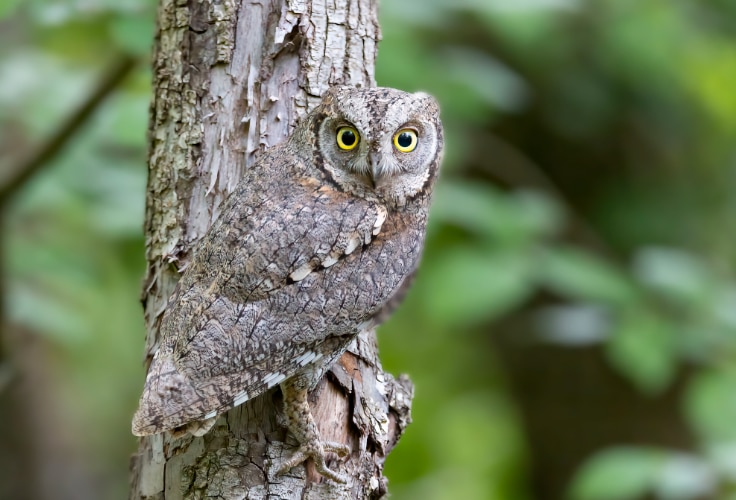
The Eurasian scops-owl is the second smallest owl in Europe, and the most widespread member of the genus Otus on the continent. Smallest individuals measure just 16 centimeters (6.3 inches) in length and weigh around 60 grams (2.1 ounces). This slender owl has short ear tufts, bright yellow eyes, and finely patterned gray-brown plumage that blends almost perfectly with the bark of trees. When resting by day, it relies on camouflage so effective that it can vanish in plain sight, aligning its body with a branch and flattening its feathers to mimic the trunk’s texture.
After dusk, the Eurasian scops-owl becomes active, emitting its clear, monotonous “peeu” call that can carry across the night for long distances. It feeds mostly on large insects such as crickets, grasshoppers, moths, and beetles, but also takes small vertebrates when available. Hunting mainly from perches, it drops to the ground or launches brief aerial chases, sometimes even seizing prey on foot. Its large eyes and sharp vision make it an efficient nocturnal insect hunter in open woodlands, orchards, and parks.
This small migratory owl breeds from the Mediterranean Basin east to Central Asia and winters south of the Sahara in wooded savannas. It favors open forests and semi-arid landscapes with scattered trees and nesting cavities, often in old woodpecker holes or walls, and readily uses nest boxes. Once widespread across much of Europe, it has declined in many northern areas due to loss of hollow trees, pesticide use, and reductions in insect prey. Still, in southern regions it remains a familiar summer sound of warm nights, its single mellow hoot echoing from olive groves and village gardens.
Why These Tiny Owls Matter
Small though they are, these owls play an essential role in their ecosystems – as predators of insects, small mammals, reptiles, and birds, and as indicators of healthy, balanced forests. Their miniature size makes them both specialized and elusive, and several rank among the world’s rarest and least-known owls. For species such as the long-whiskered owlet and Tamaulipas pygmy-owl, continued survival depends on sustained habitat protection and targeted conservation work.
Safeguarding these tiny raptors means preserving some of the most delicate branches of avian diversity – species that embody both evolutionary refinement and ecological fragility. In protecting them, we also protect the hidden complexity of forests themselves, and the quiet, intricate balance of life that unfolds at its smallest scale.


